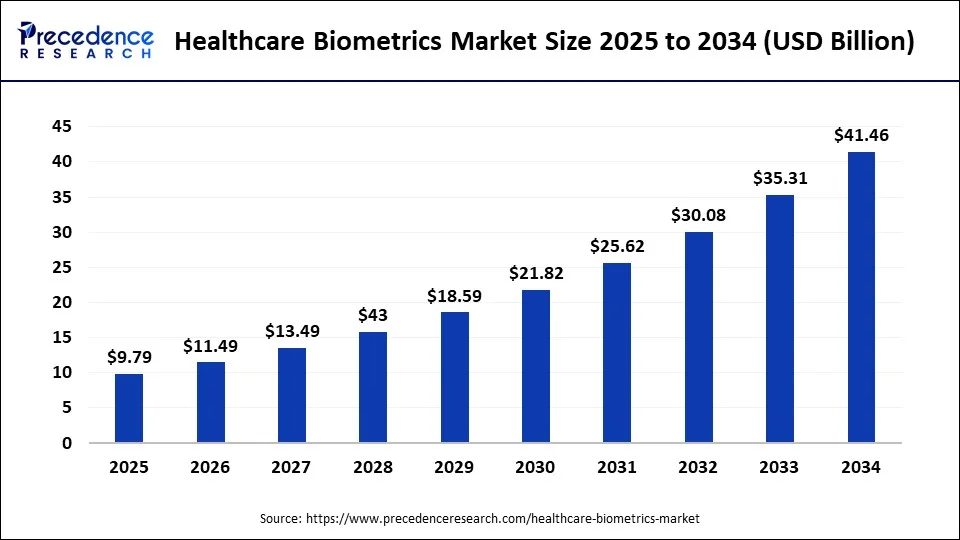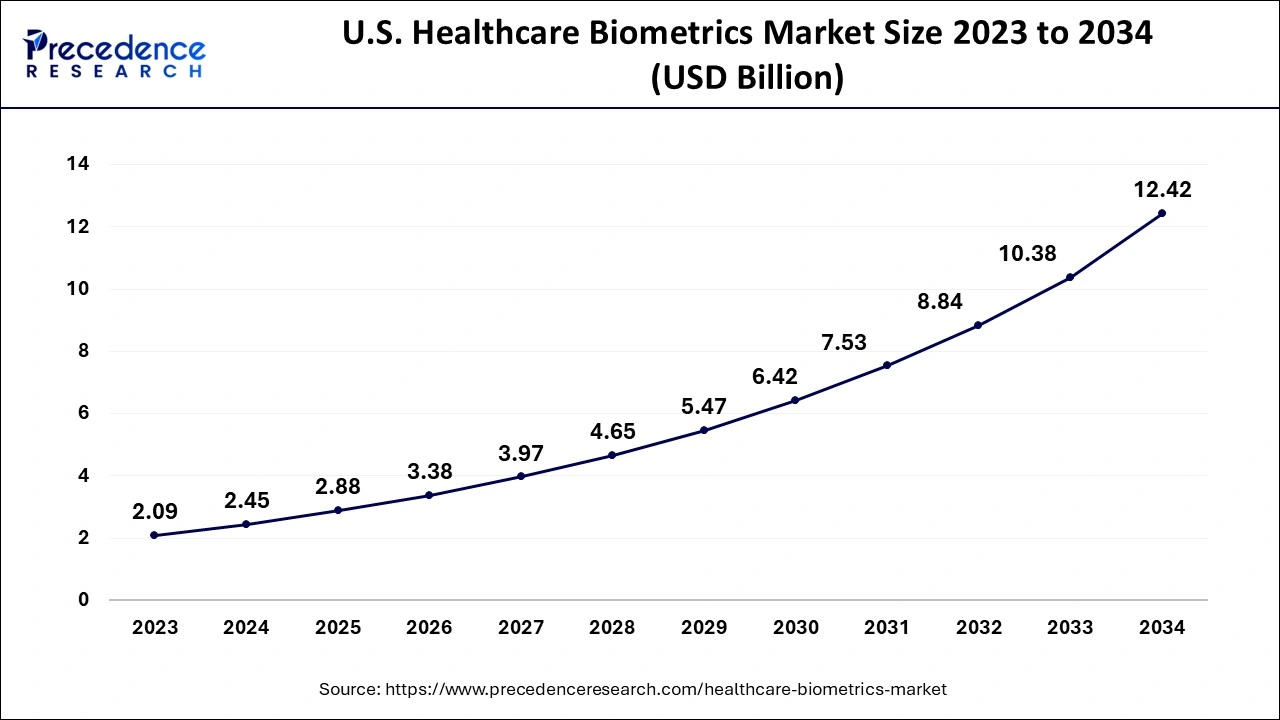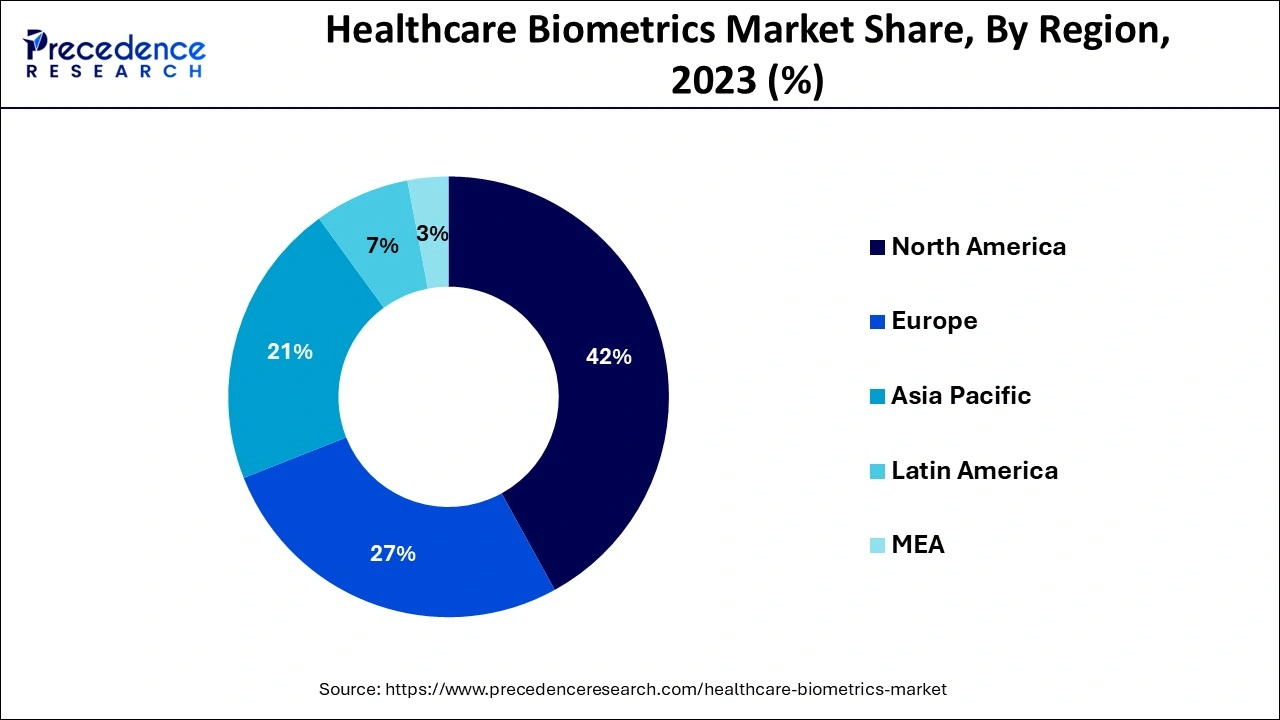January 2025
The global healthcare biometrics market size accounted for USD 8.34 billion in 2024, grew to USD 9.79 billion in 2025 and is predicted to surpass around USD 41.46 billion by 2034, representing a healthy CAGR of 17.40% between 2024 and 2034. The North America healthcare biometrics market size is calculated at USD 3.50 billion in 2024 and is expected to grow at a fastest CAGR of 17.53% during the forecast year.
The global healthcare biometrics market size is estimated at USD 8.34 billion in 2024 and is anticipated to reach around USD 41.46 billion by 2034, expanding at a CAGR of 17.40% from 2024 to 2034.

The U.S. healthcare biometrics market size is evaluated at USD 2.45 billion in 2024 and is predicted to be worth around USD 12.42 billion by 2034, rising at a CAGR of 17.59% from 2024 to 2034.

On the basis of geography, the North American market dominated the segment by holding the larger share as a result of the higher number of crimes and frauds which occur in health care system. The increase in the number of fraud cases and false data how boosted the demand for advanced biometric technology into the system which will help to safeguard the information which is held by the health care database. The registration information and patient data are gathered by these advanced systems and kept safe for future reference in order to prevent any unethical breaches into the system.

The European market proves to be the second largest sector for the healthcare biometric market as a result of the high number of fraud cases seen by this region in the healthcare sector. Along with advancements in technology the adoption for better biometric facilities has become the need of the hour.
The Asia Pacific region is expected to show a tremendous growth as a result of the increasing government assistance in the healthcare sector. The increasing adoption of modern technologies in the healthcare sector in order to gain confidence of the consumers and obtain a better revenue return has helped to boost the market for healthcare biometric system.
The main objective behind the healthcare biometrics market is to control the constant frauds that are taking place in the medical field across the world. The adoption of new technologies helps to update the security barriers that are placed in order to protect the patient data and inventory losses. The number of frauds relating to the patient data, patient history and records is rising every day which needs to be controlled by implementing advanced technologies. The market size of the healthcare biometrics is foreseen to increase during the future as a result of its increasing demand among the health care practitioners and clinicians and hence the number of clients is increasing rapidly. Even the research clinical centers and healthcare institutions are adopting these advanced technologies in order to increase the security levels of the system. This is mainly done to protect the research data and information that are obtained through clinical trials and studies.
The healthcare biometrics system performs a number of scans on the body of the individual which confirms the presence of the patient itself. These scans mainly are done over the face, palm, retina thumbprint and fingerprint. Out of these the fingerprint is the most commonly used identification mark or data of a particular individual which is also used for legal purposes and other activities. A number of frauds take place in the urban regions and big hospitals as a result of the huge number of patients that are dealt with. Minute errors by the healthcare workers to lead to such kind of frauds on a day-to-day basis. Absence of properly collected data regarding the patient or the relatives leads to mixing up of information and hence creates confusion.
During the course of the pandemic, a number of frauds were recorded regarding the identification of the patient, health records of the patient, insurance claims and identification of deceased individuals. this condition which was created as a result of the huge number of patients that were flowing into the hospitals increased the need to have better facilities and technologies in order to identify a particular patient or relative to support the medical system and avoid the occurrence of such fraud cases. With the increase in the number of healthcare facilities during the coming years the adoption of healthcare biometrics is expected to increase rapidly. Various market players are competing with each other in order to create better security scanners which provide authentic details and reduce the number of systemic errors while scanning the details of a particular individual. A drawback of the healthcare biometrics is its failure in the situations where the details of an individual get lost or altered as a result of a disease condition. Under such circumstances it is practically impossible for the system to cross verify or obtain legitimate data all the information from the individual and conduct a scan.
Every individual possesses a unique behavioral pattern and a particular type of physical features. The healthcare biometric system is mainly concerned with this data or information which gets recorded in the system in its memory and is recalled when the same person appears in front of the scanner. The scanner mainly conducts a scan of the face or the hand and collects details regarding those particular parts and cross matches with the previously obtained information which is stored in its memory. It is also used in order to identify the individuals who are kept under a close watch by those systems. It authenticates the presence or absence of that particular individual based on the data or information fed into the system by the security departments. This system comes in handy when the personal records of a particular individual are to be kept secured.
The medical data of the hospitals and the clinics are extremely confidential and cannot be revealed to anyone without the consent of the doctor or the individual itself. Patient's privacy is considered to be the primary factor when these confidential data are being recorded by the medical personnel in our health care system. Patient security has always obtained the topmost priority in any healthcare industry. A biometric scanner examines the biological data of the user by recording and storing unique physical information which attributes the presence of a particular individual in order to use them in the future for further reference of identification. The scanned data is converted into digital format with the help of software which is collected by a scanning device understood into a database in the form of biometrics to form a comparison with the already present biometric data when required. This system forms the core of the healthcare biometrics market.
Biometric scanning which includes voice or facial recognition help to provide a contactless identification process for the individual. These techniques are mainly used where or restricted area is present and needs to be protected on high priority. The benefit of the biometric system is that it avoids a huge crowd to enter into the premises of the health care system which tends to create confusion and havoc for the medical staff. With the increasing number of patients in the hospital a huge data concerning the patient or the medical staff has been collected by the health care system. This data becomes difficult to manage when handled manually. Hence the need for healthcare biometrics is going to be felt very soon by every health care system which will help to accelerate the biometrics market during the forecast period. With the increasing trend of modernization and digitalization, adoption of the healthcare biometrics system will become a very common factor for the health care systems in order to provide a premium service to its consumers. The presence of modern facilities in the health care system also attracts a huge customer base which proves to be profitable for the system. These multiple reasons will prove to be the growth factors further healthcare biometrics market during the forecast period.
| Report Coverage | Details |
| Market Size in 2024 | USD 8.34 Billion |
| Market Size by 2034 | USD 41.46 Billion |
| Growth Rate from 2024 to 2034 | CAGR of 17.40% |
| Base Year | 2023 |
| Forecast Period | 2024 to 2034 |
| Segments Covered | Technology, Application, End User, Geography |
On the basis of technology, the market is divided under face recognition, palm geometry recognition, vein recognition, fingerprint recognition and behavioral identification. Among these, the fingerprint identification market holds the largest share due to it's higher reliability and ease of access. A higher security is provided to the system with the help of DNA recognition which is foreseen to facilitate the demand for biometrics system in the healthcare sector.
The fingerprint recognition pattern is the most commonly used biometric system globally and is now gaining its market in the small-scale industry as well. Face recognition proves to be the next segment that is recently becoming popular among various sectors as a result of modernization. This system has helped to increase the resistance against fraud cases which has helped to safeguard patient data and information and thus preventing malpractice.
Hospitals dominate the segment as they make use of this advanced technology on a large scale in order to eliminate the huge crowd that tends to visit this setup while accompanying the patients. Since it becomes extremely difficult for the medical staff to operate when there is too much of chaos, the healthcare biometric system helps to authenticate the entry of the people by allowing only eligible people into the main premises of the hospitals.
The clinics and healthcare institutions form the next sector where this system is used in order to maintain the rotation of crowd and avoid unnecessary breach into the normal functioning of the hospital. Research centers and laboratories also require high level security in order to protect the data and information of the patients. In order to maintain absolute privacy and security of the patient information and confidentiality of the data these advanced security features need to be adopted by the healthcare system and thus upgrade its functioning and facilities.
By Technology
By Application
By End User
By Geography
For inquiries regarding discounts, bulk purchases, or customization requests, please contact us at sales@precedenceresearch.com
No cookie-cutter, only authentic analysis – take the 1st step to become a Precedence Research client
January 2025
December 2024
February 2025
April 2024